Astrophysics: the first galaxies during the Epoch of Reionization
A significant portion of my work if focused on the Epoch of Reionization and the properties of the first galaxies.
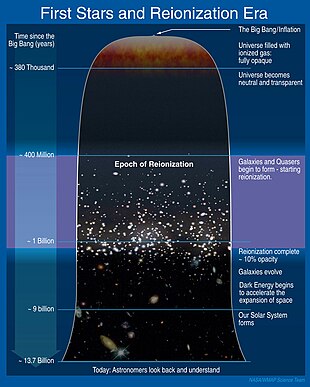
Intro: The Epoch of Reionization
Start with an introduction into what is the Epoch of Reionization and what questions are we trying to answer.
The Epoch of Reionization

The Epoch of Reionization is a pivotal chapter in the story of the universe. It marks the era when the first stars and galaxies appeared, transforming the cosmos from a cold, dark place into the vibrant luminous universe we see today. Beginning a few hundred million years after the Big Bang and lasting about a billion years, this period saw the ultraviolet (UV) light from these early stars and galaxies break apart hydrogen atoms, turning them into free protons and electrons. This process, called reionization, changed the universe from being opaque to becoming transparent, allowing light to travel freely across vast distances.
The Big Unanswered Questions
What were the sources of ionizing radiation?
One of the biggest mysteries surrounding the Epoch of Reionization is the exact nature of the sources responsible for the ionizing radiation. While we believe that the first stars and galaxies played a significant role, we still don't know whether they were the only contributors. Other candidates include quasars, powered by supermassive black holes, and possibly even more exotic sources like decaying dark matter. Understanding the properties and contribution of each source is essential to understanding how reionization occurred and what types of objects dominated this process in the early universe.
How did ionizing photons escape and reionized the hydrogen?
During reionization, the universe was filled with thick clouds of neutral hydrogen gas, which absorbed much of the radiation emitted by the first stars and galaxies. One key question is: how did the ionizing photons (UV light) escape galaxies and reionized the hydrogen in the Universe? This involves understanding how "bubbles" of ionized gas formed and spread as the ionizing radiation broke through the neutral hydrogen. These bubbles eventually grew and overlapped, creating fully ionized regions. But the way photons traveled within and outside of the objects producing them and remains a subject of ongoing research.
What is the exact timeline of Reionization?
Another important question revolves around the timeline of the Epoch of Reionization. Did it happen gradually, with the universe slowly becoming ionized over hundreds of millions of years, or were there bursts of rapid ionization? Current observations suggest that reionization may have been a patchy process, starting in some regions while others remained neutral for longer. Determining the exact timeline is crucial for understanding when different structures, like galaxies and black holes, formed and how they influenced the universe's evolution.
Neutral gas properties of Lyman continuum emitting galaxies
Exploring how ionzing photons escape from nearby star-forming galaxies. [August 2018]
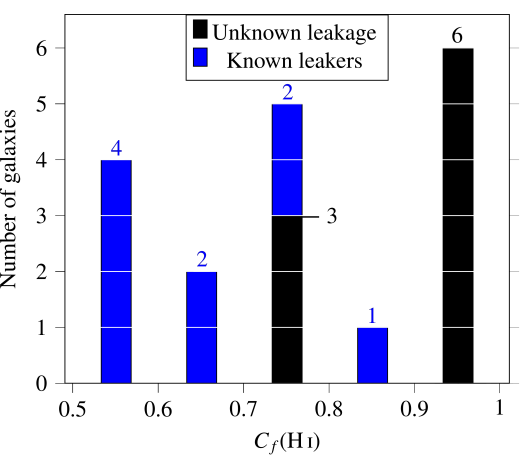
Neutral gas properties of Lyman continuum emitters
In my 2018 article, I studied how certain galaxies which may resemble the first galaxies formed in the Universe. These galaxies leak ionizing photons, which make them interesting to study in the context of the Epoch of Reionization.
Understanding the UV Light
The study included analyzing the ultraviolet (UV) light emitted by these galaxies. UV light is a type of light that is invisible to our eyes but is very important in the context of understanding the production and propagation of ionizing hydrogen. By fitting this UV light to models, we were able to extract to key insights into the gas properties of these galaxies to understand how effectively ionizing photons were escaping the galaxy environment.

Hydrogen Coverage

I looked at the geometrical distribution of the hydrogen gas in these galaxies. I made histograms to show the different amounts of hydrogen coverage for galaxies with a detected leakage of ionizing photons, and a comparison sample of other galaxies. Most leakers have low coverage of hydrogen (Cf(HI)), suggesting this plays a significant role in enabling photons to escape.
Key Findings
The main discovery of the paper is that the gas in these leaking galaxies isn't evenly distributed. Instead, it has a "patchy" structure, which means there are clumps and holes. This patchiness allows some ionizing photons to escape from the galaxy. When these photons escape, they can reach the hydrogen gas surrounding the galaxy and cause it to ionize, or break apart. This process is crucial for understanding how the hydrogen in the universe may have been ionized by galaxies during the Epoch of Reionization.

Accurately predicting the escape fraction of ionizing photons.
Finding ways to predict how many photons escape galaxies.
Accurately predicting the escape fraction of ionizing photons
In a companion paper to my 2018 research, written by John Chisholm, we looked at a different challenge: how to estimate the fraction of ionizing photons that manage to escape from galaxies, without directly measuring them. This is crucial because directly observing the ionizing photons escaping from galaxies in the early universe is extremely difficult due to the distance and the obstacles in their path.
Using Other Observables
Since directly measuring these escaping photons is so hard, we focused on using indirect methods. In this paper, we explored how to estimate the "escape fraction" of ionizing photons by looking at other properties of galaxies that we can observe more easily. These properties, or observables, include specific emission or absorption features in the spectra of the galaxy's which are empirically connected to the escape of ionizing photons.
What observables might work?

Some of the indirect estimators we look at are the Si II (Sillicon atom who got ionized once) covering fraction and Lyman-alpha, which is a resonant transition from the neutral Hydrogen, when combined to the dust extinction. These two features indirectly and directly trace the neutral hydrogen properties, and when combined with the amount of dust, they provide relatively reliable indirect escape fraction diagnostics.
Key Findings
Following the first paper which found that a patchy interstellar medium enables the ionizing photons to escape galaxies, this paper finds that we can use this information to establish indirect diagnostics that provide reliable estimates into the amount of ionizing photons escaping galaxies, a key insight for studying the impact of star-forming galaxies during the Epoch of Reionization.
The origin of the escape of Lyman-alpha and ionizing photons
Diving further into how ionzing photons escape from local star-forming galaxies.
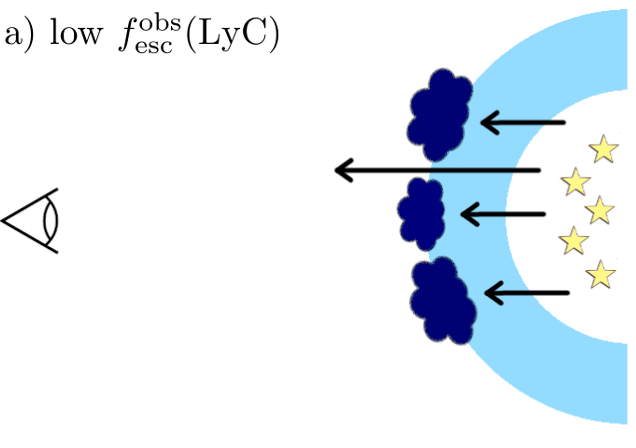
The Escape of Lyman α and Ionizing Photons in Galaxies
Understanding how galaxies in the early universe allowed ionizing radiation to escape is key to figuring out how cosmic reionization occurred. We already published a paper on these aspects in 2018, but in 2020, we went further and studies a larger sample of star-forming galaxies that emit ionizing photons, extending the analysis to the mechanims enabling the escape of Lyman-α photons as well.
Fitting spectroscopic observations to extract insights into gas properties
Similarly to the 2018 study, this study included analyzing the ultraviolet (UV) light emitted by these galaxies. We fit the UV spectra of these galaxies with models including spectral features from stars and from the absorbing gas. Doing so enabled us to extract to key insights into the gas properties of these galaxies to understand how this connects to the ionizing photon leakage.
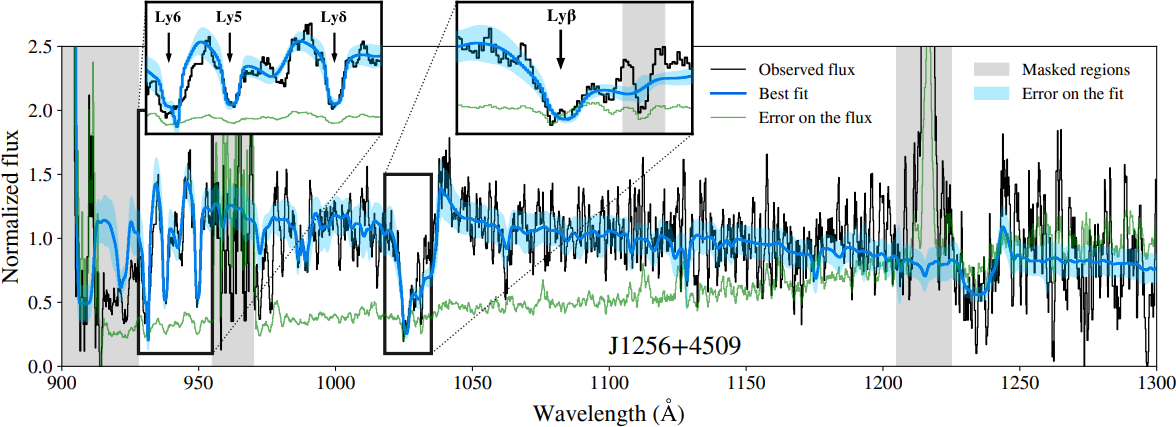
Connecting gas properties to the escape of Lyman-α ionizing photons
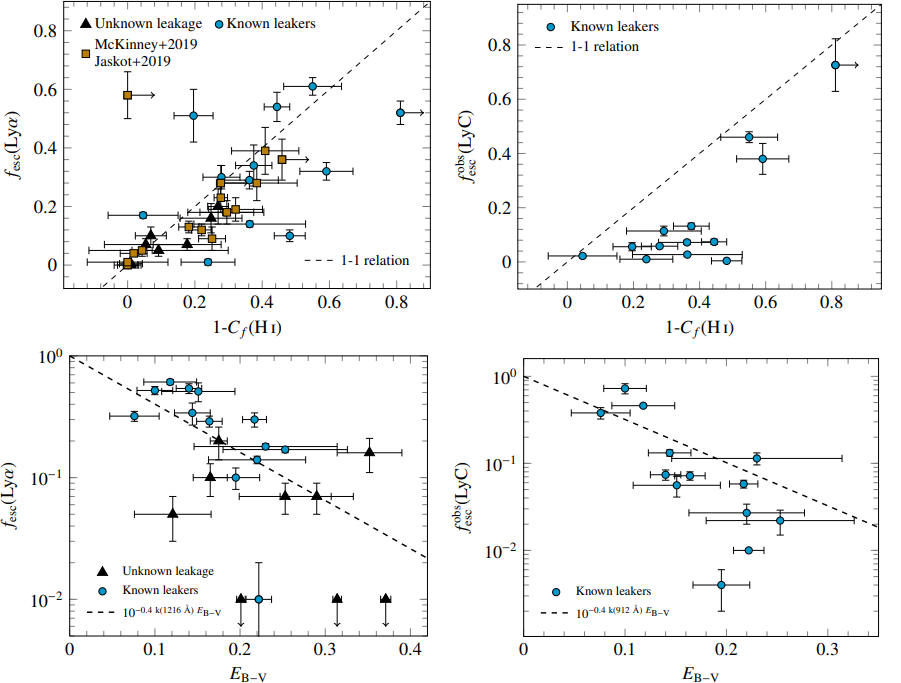
Some of the trends we looked at, connecting the measured escape fraction of Lyman-alpha and ionizing photons to the hydrogen covering fraction and the dust extinction. We discovered that galaxies with largest escape fractions of ionizing photons and Lyman-alpha photons all had lower H I covering fractions, meaning there is less neutral gas in their path, and lower dust extinction, meaning there is supposibly lower amounts of dust absorbing the Lyman-α and ionizing photons. Essentially, if a galaxy has "holes" or low-density regions in its neutral gas and dust distribution, photons can leak out more easily.
Visualizing the Findings
Based on our findings, I made a sketch summarizing how ionizing photons escape in star-forming galaxies. It pictures two escape mechanisms, depending if the escape if a few percent or tens of percent.

Key findings
We found that galaxies with a porous interstellar medium allow Lyman-α and ionizing photons to escape. However, for galaxies with the highest escape fractions, this porosity alone isn’t enough. These galaxies are likely "density-bounded," meaning they have little or no neutral gas along most lines of sight, allowing more radiation to leak out. This discovery helps understanding how ionizing radiation can escape from early galaxies, providing valuable clues for the Epoch of Reionization.
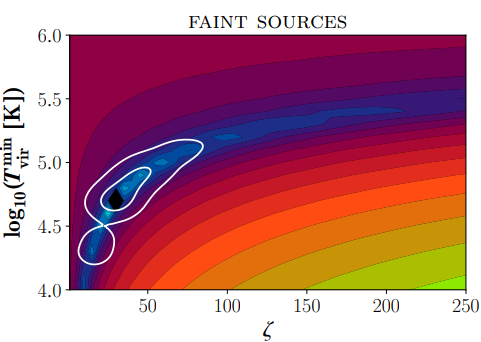
Inferring the properties of the sources of Reionization
A different approach into understanding which sources reionized the Universe.
Inferring the properties of the sources of Reionization using the morphological pattern spectra of the ionizing regions
The exact nature of the sources responsible for the Epoch Of reionization remains a key question. In this study, we use a new approach to infer the properties of the underlying sources by examining the shapes and sizes of the ionized regions they create in 21-cm tomographic observations.
What Are Morphological Spectra?
Morphological spectra allow us to analyze the shape and structure of ionized regions in the early universe. By examining these structures, we can infer the properties of the galaxies or other sources that emitted ionizing photons. These sources could include small, faint galaxies or larger, brighter ones, each contributing differently to the reionization process.
Comparing Different Reionization Scenarios

In our study, we explored two different reionization scenarios:
- Faint Galaxies: A scenario where many small, low-mass galaxies contributed to reionization.
- Bright Galaxies: A scenario dominated by fewer, larger galaxies that emitted more ionizing radiation.
Using Markov Chain Monte Carlo (MCMC) to Infer the Properties of Reionization Sources
To infer the properties of the sources including their number, brightness, and efficiency in ionizing the surrounding hydrogen, we used a Markov Chain Monte Carlo (MCMC) approach. MCMC is a technique used to explore all possible values of the unknown properties of a system based on what we observe. In this case, we start with observations of ionized regions in the universe and then use MCMC to "guess" the properties of the sources that created them. Instead of guessing randomly, MCMC generates a sequence of educated guesses, using each guess to improve the next one. This process eventually leads us to a set of properties that best explain the observations.
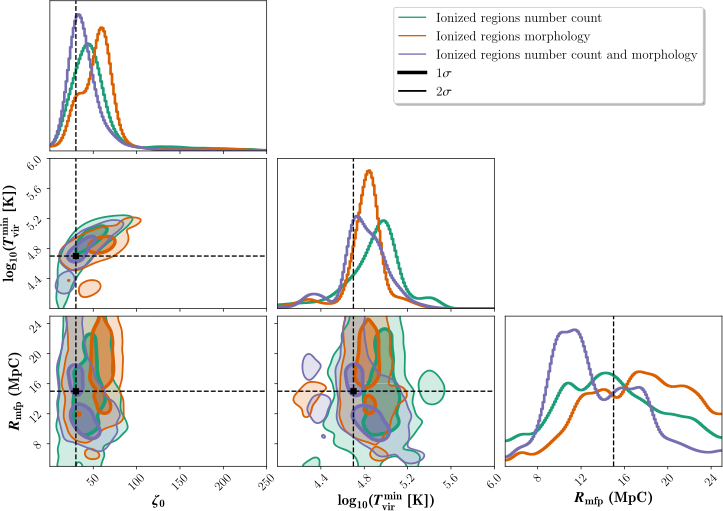
The Morphological Pattern Spectra is an alternative to the Power Spectrum
Other approaches exist to infer the properties of the sources from 21-cm observations. The Power spectrum is particularly interesting because easy to compute and well understood. Yet it can be biased by noise and residual foregrounds. We tried to infer the sources properties on contaminated data, and found the the morphology of the ionizing sources is more robust, i.e. provides less biased estimates than the power spectrum. This doesn't mean the morphological spectra should be used instead, but suggest it is rather a nice additional approach to get more robust results.

Why do the regions morphology trace the source properties?

It can be an interesting exercise to try to understand why the regions morphology can trace the sources properties so well. We explored the connection between the morphological properties and the underlying physics, here the number of ionizing photons emitted per unit of time and volume. We found a clear link between the morphological properties of the ionizing regions and the underlying source properties, showcasing that morphological pattern spectra have a clear connection to the underlying physics.
Key findings
This research proposed for the first time a novel approach to inferring the source properties using the morphology of the ionized regions in 21-cm observations. Combining morphological spectra with traditional methods like the power spectrum provides a more complete picture of the reionization process. This is an important step forward to understanding how we can optimize the information from future observations from the Square Kilometer Array.
Interpreting UV spectra using a Virtual Galaxy
A pioneering approach into interpreting spectroscopic observations with RHD simulations.
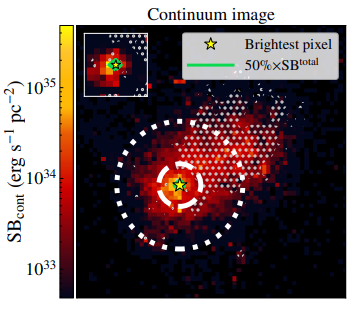
Interpreting the Line Spectra from CLASSY Using a Virtual Galaxy from a High-resolution Radiation-hydrodynamic Simulation
In this study, we use advanced simulations of a virtual galaxy to help interpret real observations of galaxies. By comparing the simulated data to observations of nearby star-forming galaxies, we can better understand the complex processes happening in the interstellar medium (ISM)—the gas and dust between stars. These processes influence how galaxies evolve and emit light, especially in the ultraviolet (UV) spectrum, and some are key insights into the production and propagation of ionizing photons.
The Challenge of Interpreting Metal Lines
Observing certain metal lines in the UV spectrum, such as Si II and C II, gives us crucial insights into the ISM. However, interpreting these metal lines is tricky because many factors influence the line shapes, like gas movement, density, and the presence of outflows from star formation. To untangle this complexity, we used a high-resolution radiation-hydrodynamic (RHD) simulation of a virtual galaxy. This simulation lets us produce realistic, mock spectra—basically, simulated observations—from various viewing angles, which we then compared to real data.
Comparing global line properties
A first important step is to understand whether the line properties in the simulation are consistent with the observations. To do so, we can compare a bunch of line properties such as the equivalent width, residual flux, and offset velocity.
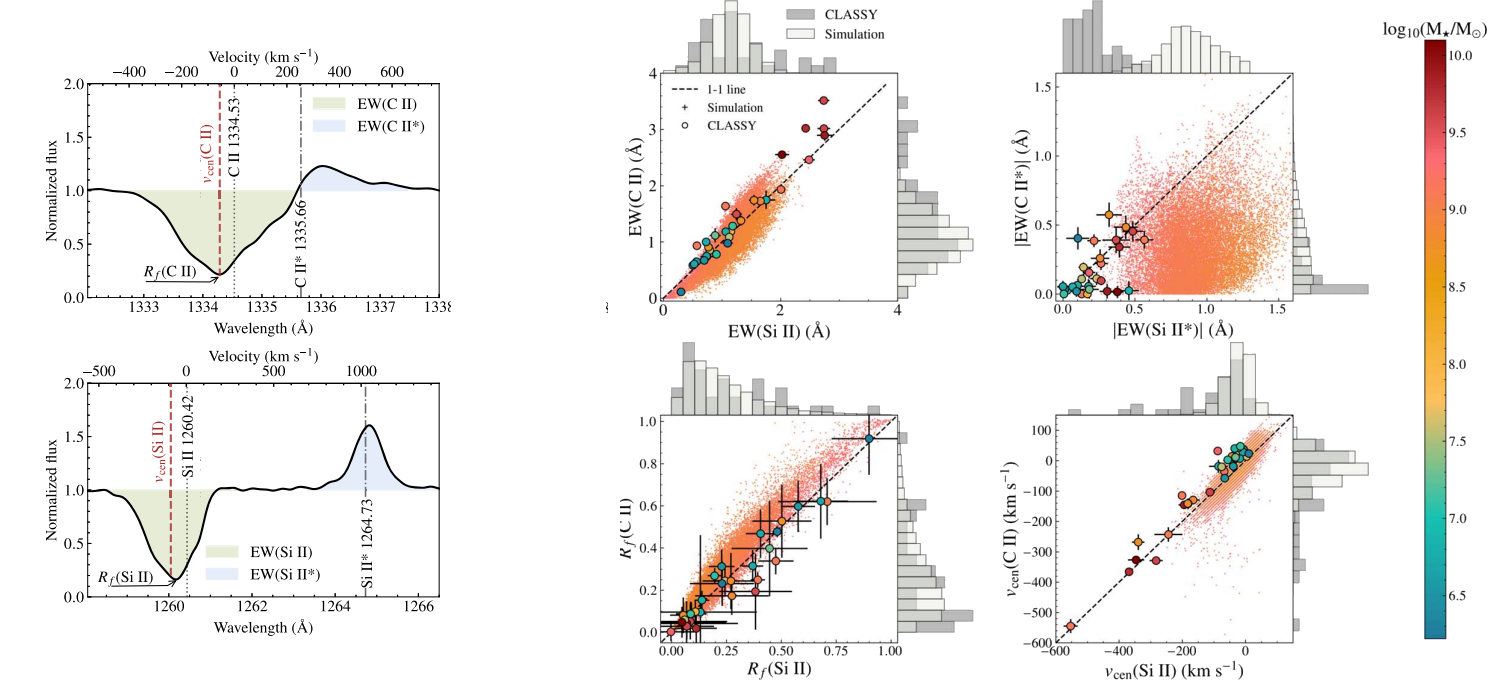
Matching Real and Simulated Data

We compared the virtual galaxy’s mock spectra to observations from a sample of 45 star-forming galaxies, collected by the COS Legacy Spectroscopic Survey (CLASSY). These galaxies have similar properties to galaxies seen in the early universe, making them ideal for understanding cosmic reionization. By matching the mock and real spectra, we could investigate whether the environment of the virtual galaxy provides a good match to the observed galaxies. We obtained a really agreement between mock and observed spectra for 37 galaxies.
Diving into the physics responsible for the line spectra
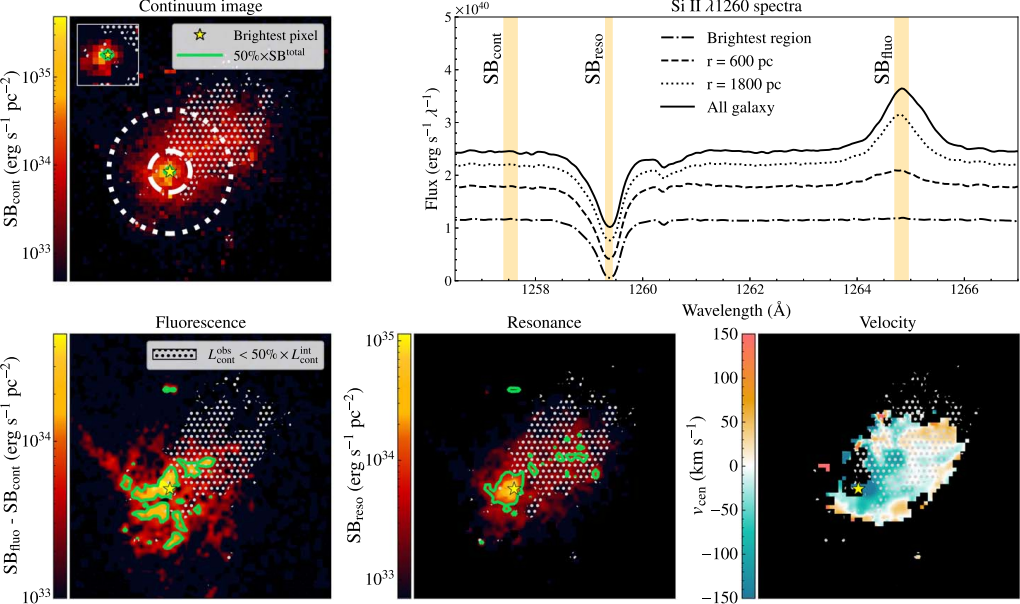
Understanding line spectra is really complicated. But having matched a virtual galaxy to real galaxy means we can dive in the simulation to understand what processes are responsible for the specific properties and shape we observe in real galaxies. This is a tremendous step forward to understand how to interpret these line spectra.
Key Findings
We found that the simulated spectra rom the virtual galaxy match many real observations very well. We were able to pinpoint where specific spectral features, such as resonant absorption or fluorescent emission, emerge in the galaxy’s ISM. We also discovered that some observations missed parts of this emission due to the limited size of the telescope’s aperture, suggesting that aperture effects must be accounted for when interpreting real data. Overall, this is a truly novel path towards analyzing spectroscopic observations and extracting vital insights to understand the physical phenomena at play within the galaxy.
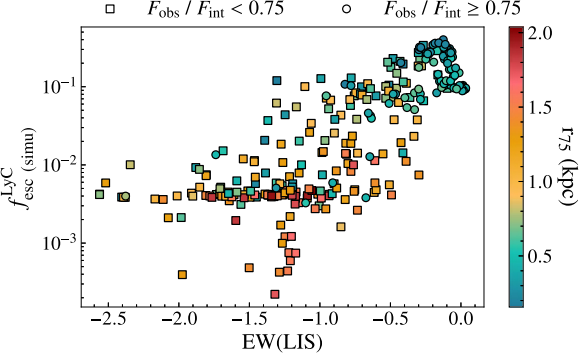
Using a Virtual Galaxy to understand the ionzing photon escape
Extending the previous work by diving deeper in the virtual galaxy physics.
Using the Si II and C II Line Spectra as Tracers of Galaxy Evolution and Lyman Continuum Leakage
Building upon the first proof-of-concept paper, we dive further into how to a careful matching between virtual and real galaxies to understand better the physics governing galaxy evolution and ionizing photons leakage.
Matching Real and Simulated Data in a different sample
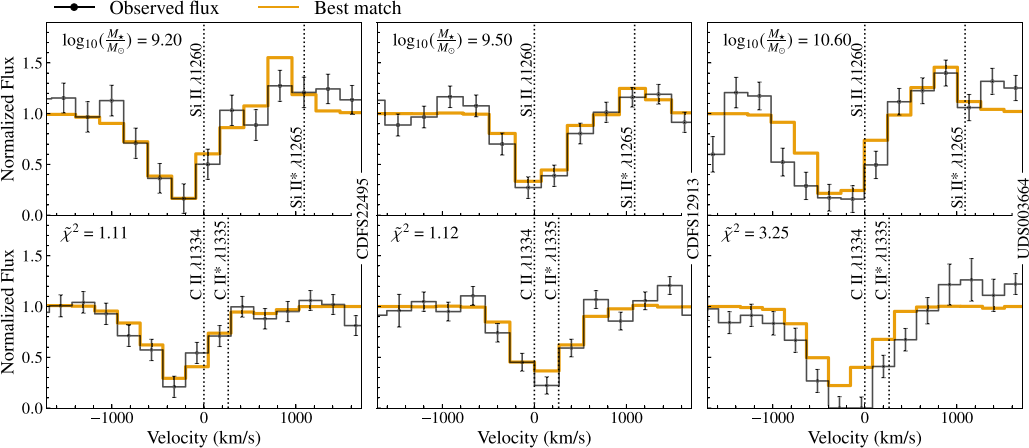
We compared the virtual galaxy’s mock spectra to observations from a sample of ~100 star-forming galaxies from the Vandels sample. These galaxies are further away fros us than the typical nearby galaxies we used so far, and their observations do not have the same quality. But a matching process is still possible
Exploring the physical conditions that explain the agreement between simulation and observation.

For 85% of the galaxies we study, we find a simulated spectrum that matches the observations. Why is that? Well diving a bit deeper in the galaxy evolution history, we realized that all the good matches we found in the simulation originated from times where the virtual galaxy is having star formation bursts. And we know that the Vandels galaxies are also in that peculiar phase of their evolution. So it makes sense. When the virtual galaxy is having a star formation burst, its environment very much resemble real galaxies which are also having such a burst. The key for understanding line spectra is therefore probably understanding the dynamics of star formation bursts and how it changes the galaxy environment.
Using the virtual galaxy to estimate escape fractions.
Once we know that the virtual galaxy is a quite good representation of the environment of these galaxies, we can explore whether we can indirectly estimate the escape fraction of ionizing photons from the simulation. We did that and it matches very well with other estimates of the escape fraction for these galaxies. One more point for the accuracy of the physics in the simulation.


In the simulation, we find that the escape of ionizing photons is emprically connected to several factors: the properties of low-ionization state (LIS) lines, the size of galaxy, and the dust attenuation. Directions where more ionizing photons escape show weak absorption lines, less dust, and a compact morphology. This suggests that ionizing are likely escaping through small, low-density regions with less neutral gas and dust.
Key Findings
This study extends the success of using a zoom-in simulation approach to analyze UV absorption and emission lines, as seen in recent studies. It reaffirms the potential of these methods in understanding the factors contributing to various and intricate line profiles in galaxies. It also highlights their relevance to provide valuable insights, including estimates of the ionzing escape fraction for reionization era observations with JWST.
A negligible contribution of two luminous galaxies during the Epoch of Reionization
Looking at James Webb Space Telescope of two luminous galaxies formed .
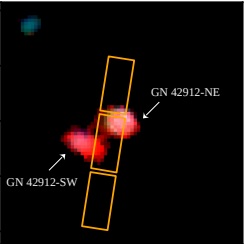
A negligible contribution of two luminous galaxies during the Epoch of Reionization

This article explores two luminous galaxies at redshift 7.5 (700 million years after the Big Bang), using data from the James Webb Space Telescope (JWST). The study aims to estimate the contribution of these galaxies to the ionizing photon budget required during the Epoch of Reionization (EoR). Both galaxies, GN 42912-NE and GN 42912-SW, were examined for their ability to release ionizing photons, which play a crucial role in ionizing hydrogen in the early universe. The Mg II emission lines were used as indirect tracers of the escape fraction of ionizing photons.
Extracting information from the UV spectra
A first important step is to analyze the spectroscopic observations and the emission lines to infer the global galaxy properties, such as the galaxy ionization state or its metallicity. The line flux and properties, especially those of Mg II can also be used to infer the ionizing escape fraction.
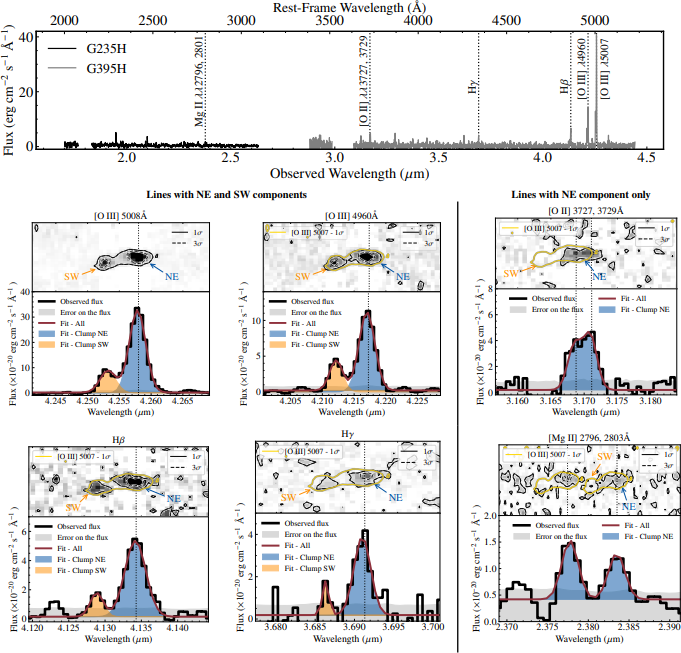
Deriving LyC escape fractions
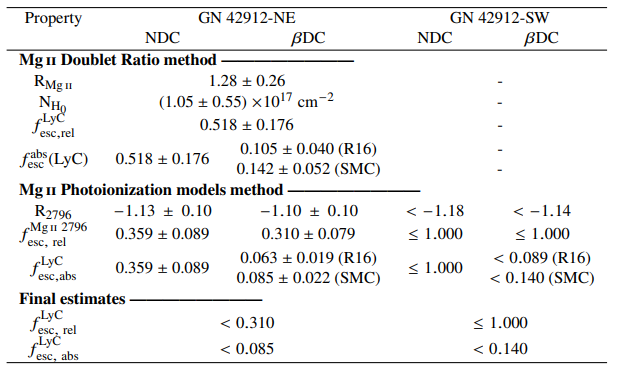
Using the properties we extracted, we can calculate ionizing/LyC photons escape fractions through some recipes. By using different methods or asumptions, we can come up with different estimates, evaluate their consistency, and extract an overall value that is representing the true expected escape fraction.
Checking their consistency

LyC escape fraction trends have been well studied over the last decade. Which means we can compare our estimates to see whether they are consistent with the rest of the universe.
Understanding where we stand in the context of reionization models
Pre-JWST reionization models have predicted what should be the average escape fraction of galaxies during the Epoch of Reionization. Not all these models match, and here we compare what out two galaxies tell us about these models. Unfortunately, not much yet.
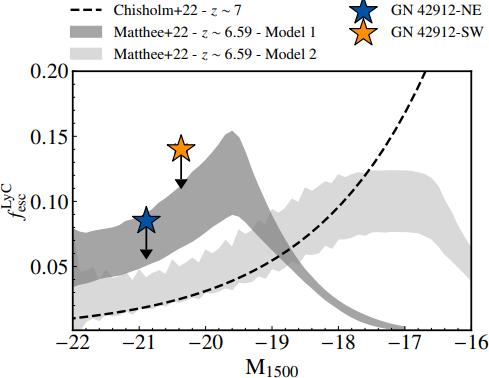
Key Findings
This research provides important insights into two galaxies and their impact on the reionization process. By using Mg II emission lines as indirect diagnostics, we highlight that these two galaxies did not play a major role in the reionization process, which may suggest that luminous galaxies are not a dominant player. More observations will obviously be needed to shed more light.